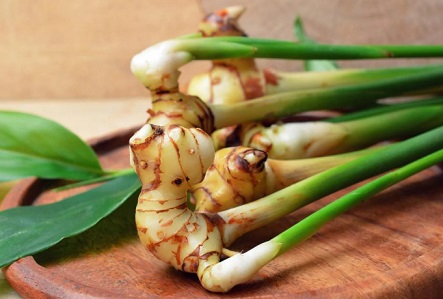Nikhil Prasad Fact checked by:Thailand Medical News Team Dec 22, 2024 3 months, 3 weeks, 1 day, 1 hour, 24 minutes ago
Medical News: Pulmonary fibrosis (PF) is a severe and often fatal lung disease that has gained increasing attention in recent years. It involves the progressive scarring of lung tissue, leading to respiratory failure and, in many cases, death within a few years of diagnosis. Pulmonary fibrosis is characterized by the replacement of normal lung tissue with fibrotic tissue, reducing lung function and causing persistent breathlessness. This condition has become even more concerning with the emergence of COVID-19, as some survivors of the virus develop long-term lung damage, including Pulmonary fibrosis.
 Alpinia Officinarum Extract as a Potential Treatment for Lung Fibrosis
Alpinia Officinarum Extract as a Potential Treatment for Lung Fibrosis
The exact causes of Pulmonary fibrosis are not fully understood, but risk factors include smoking, aging, air pollution, infections, and exposure to harmful chemicals. Additionally, genetic predisposition and oxidative stress contribute to its development. Despite significant advancements in medical research, effective treatments for Pulmonary fibrosis remain limited, creating an urgent need for innovative therapies.
The Promise of Alpinia Officinarum Rhizome Extract
Alpinia officinarum, commonly known as lesser galangal, is a medicinal herb from the Zingiberaceae family. Its rhizomes contain potent bioactive compounds, including flavonoids like galangin, kaempferide, and pinocembrin, which exhibit antioxidant, anti-inflammatory, and antifibrotic properties. Traditionally used to treat ailments such as inflammation, infections, and stomachaches, Alpinia officinarum has recently attracted scientific attention for its potential role in combating oxidative stress-related diseases. This
Medical News report delves into a groundbreaking study that investigated the protective effects of Alpinia officinarum rhizome extract (AO extract) on lung fibrosis induced by bleomycin in animal models.
Study Overview
Researchers from the Anatomy and Embryology Department and the Clinical Pharmacology Department at Menoufia University in Egypt collaborated on this study. The aim was to evaluate the efficacy of AO extract in mitigating bleomycin-induced lung fibrosis in rats and to explore the underlying mechanisms involving the Sirt1 and Nrf2 antioxidant pathways.
To induce lung fibrosis, albino rats were administered bleomycin intratracheally. Subsequently, the experimental group received AO extract orally at a dosage of 200 mg/kg daily for 28 days. At the end of the study, the rats were euthanized, and their lung tissues were subjected to biochemical, molecular, and histopathological analyses.
Key Findings
The results of the study were compelling, revealing several beneficial effects of AO extract on lung fibrosis:
-Reduction in Oxidative Stress: Bleomycin significantly increased oxidative stress markers, such as malondialdehyde (MDA), in lung tissue. AO extract administration effectively reduced MDA levels, indicating its ability to counteract oxidative damage.
&
lt;strong>-Anti-Inflammatory Effects: The study observed elevated levels of pro-inflammatory cytokines, including tumor necrosis factor-alpha (TNF-α) and interleukin-6 (IL-6), in the bleomycin group. AO extract significantly lowered these inflammatory markers, suggesting its potent anti-inflammatory properties.
-Histopathological Improvements: Histological analysis of lung tissues showed severe injuries in the bleomycin group, including tissue scarring and collagen deposition. AO extract-treated rats exhibited markedly improved lung architecture, with reduced fibrosis and restored tissue integrity.
-Modulation of Key Pathways: The study highlighted the role of AO extract in activating the Sirt1 and Nrf2 antioxidant pathways. Sirt1 is a protein deacetylase that regulates cellular stress responses, while Nrf2 is a transcription factor that enhances the production of antioxidant enzymes. AO extract enhanced the expression of both Sirt1 and Nrf2, thereby mitigating oxidative stress and promoting cellular repair mechanisms.
Decreased Fibrotic Markers: Immunohistochemical analysis revealed lower levels of fibrotic markers, such as α-smooth muscle actin and transforming growth factor-beta 1, in the AO-treated group. These findings underscore the antifibrotic effects of AO extract.
Mechanisms of Action
The protective effects of AO extract are attributed to its ability to regulate multiple molecular pathways:
-Antioxidant Activity: AO extract scavenges free radicals and reduces oxidative stress, which is a key driver of lung fibrosis.
-Anti-Inflammatory Effects: By inhibiting pro-inflammatory cytokines, AO extract prevents chronic inflammation, a major contributor to fibrotic tissue formation.
-Sirt1/Nrf2 Pathway Activation: The activation of Sirt1 promotes mitochondrial health and cellular repair, while Nrf2 enhances the expression of antioxidant enzymes, creating a synergistic effect that protects lung tissue from damage.
Inhibition of Fibrotic Pathways: AO extract downregulates the expression of genes associated with fibrosis, thereby preventing the excessive deposition of collagen and extracellular matrix.
Conclusion
The findings of this study provide strong evidence that Alpinia officinarum rhizome extract can effectively protect against bleomycin-induced lung fibrosis. Its multifaceted action - encompassing antioxidant, anti-inflammatory, and antifibrotic effects - makes it a promising candidate for the development of new treatments for pulmonary fibrosis. By targeting the Sirt1/Nrf2 pathways, AO extract not only mitigates oxidative stress but also promotes the repair and regeneration of damaged lung tissue.
While these results are promising, further research is necessary to validate the safety and efficacy of AO extract in human trials. If successful, this natural compound could revolutionize the management of lung fibrosis, offering hope to millions of patients worldwide who currently face limited treatment options. The study’s emphasis on natural bioactive compounds also highlights the potential of herbal medicine in addressing complex diseases like Pulmonary fibrosis.
The study findings were published in the peer-reviewed journal: Morphologie.
https://www.sciencedirect.com/science/article/abs/pii/S1286011524001899
For the latest on Lung Fibrosis, keep on logging to Thailand
Medical News.
Read Also:
https://www.thailandmedical.news/news/67-9-percent-of-patients-who-had-severe-covid-19-pneumonia-have-evidence-of-fibrosis-three-months-after-discharge
https://www.thailandmedical.news/news/covid-19-is-not-mild-as-most-will-develop-lung-fibrosis-10-percent-of-all-lung-transplants-in-u-s-now-go-to-post-covid-patients
https://www.thailandmedical.news/news/russian-researchers-find-that-vitamin-d-can-help-combat-lung-fibrosis
https://www.thailandmedical.news/news/individuals-who-had-covid-19-without-pneumonia-at-higher-risk-for-pulmonary-fibrosis-than-those-with-pneumonia
https://www.thailandmedical.news/news/the-uniqueness-of-post-covid-lung-fibrosis-the-increased-expression-of-atp12a-protein
https://www.thailandmedical.news/news/long-term-lung-healing-even-after-mild-or-moderate-covid-19-many-could-develop-lung-fibrosis
https://www.thailandmedical.news/news/new-biomarker-discovered-for-progressive-pulmonary-fibrosis
https://www.thailandmedical.news/news/hypoxia-and-invadosomes-in-idiopathic-pulmonary-fibrosis
https://www.thailandmedical.news/news/vitamin-e-can-help-with-lung-fibrosis
https://www.thailandmedical.news/news/breaking-doctor-from-uc-san-diego-warns-of-new-covid-19-manifestations-such-as-dermatomyositis-muscular-pains-and-alerts-about-lung-fibrosis
https://www.thailandmedical.news/news/japanese-scientists-uncover-pathways-involved-in-lung-fibrosis-by-using-new-mouse-model
https://www.thailandmedical.news/news/breaking-covid-19-news-44-9-percent-of-post-covid-individuals-develop-lung-fibrosis-irrespective-of-asymptomatic-or-mild-infections-jn-1-is-worse
https://www.thailandmedical.news/news/covid-19-news-sars-cov-2-triggers-epidermal-growth-factor-receptor-signaling-pathway,-leading-to-lung-fibrosis-and-lung-cancer-erlotinib-helps
https://www.thailandmedical.news/news/ucla-study-finds-that-covid-19-infections-drives-endothelial-cell-like-myofibroblasts-towards-actual-myofibroblasts-causing-pulmonary-fibrosis
https://www.thailandmedical.news/news/unraveling-the-enigma-of-post-covid-lung-fibrosis-maladaptive-signals-drive-fibroproliferation,-cedars-sinai-researchers-reveal
https://www.thailandmedical.news/news/breaking-ragon-institute-scientists-discover-new-subset-of-immune-cells-that-may-hold-the-key-to-fighting-autoimmune-fibrosis-and-severe-covid-19
https://www.thailandmedical.news/news/breaking-silent-tsunami-of-post-covid-lung-fibrosis-occurring-among-many-indian-researchers-warn-that-even-asymptomatics-are-at-risk
https://www.thailandmedical.news/news/breaking-study-finds-that-diabetes-can-also-contribute-to-the-development-of-lung-conditions-such-as-idiopathic-pulmonary-fibrosis-ipf
https://www.thailandmedical.news/news/long-covid-news-stanford-study-shows-that-innate-immune-cell-activation-causes-lung-fibrosis-that-can-lead-to-long-covid-breathing-problems
https://www.thailandmedical.news/news/university-of-virginia-study-finds-that-sars-cov-2-infections-triggers-reduction-in-circulating-monocytes-that-leads-to-persistent-post-covid-pulmonar
https://www.thailandmedical.news/news/irrespective-of-severity-40-percent-of-post-covid-pneumonia-patients-still-have-impaired-lung-diffusion-and-22-percent-developed-lung-fibrosis-a-year-
https://www.thailandmedical.news/news/great-news-most-post-covid-individuals-will-develop-lung-issues-similar-to-idiopathic-pulmonary-fibrosis-ipf-with-potential-serious-outcomes
https://www.thailandmedical.news/news/breakthrough-university-of-alabama-study-finds-that-the-drug-to-treat-blood-cancer-venetoclax-could-be-repurposed-to-reverse-lung-fibrosis
https://www.thailandmedical.news/news/breaking-covid-19-latest-sars-cov-2-induces-immunoparalysis-of-human-host,-infects-monocytes,-macrophages-and-can-cause-fibrosis-in-post-covid-19
